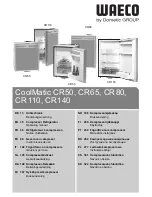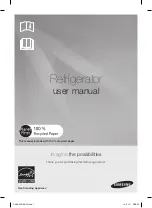
16
3. Empty the ice bin.
4. Depending on the model, turn the Temperature Control or
Refrigerator Control to OFF. See “Using the Controls.”
5. Unplug refrigerator.
6. Empty water from the defrost pan.
7. Clean, wipe, and dry thoroughly.
8. Take out all removable parts, wrap them well, and tape them
together so they don’t shift and rattle during the move.
9. Depending on the model, raise the front of the refrigerator so
it rolls more easily OR screw in the leveling legs so they don't
scrape the floor. See “Adjust the Doors.”
10. Tape the doors closed and tape the power cord to the back
of the refrigerator.
When you get to your new home, put everything back and refer to
the “Installation Instructions” section for preparation instructions.
Also, if your refrigerator has an automatic ice maker, remember to
reconnect the water supply to the refrigerator.
TROUBLESHOOTING
Try the solutions suggested here first in order to avoid the cost of an unnecessary service call.
Your refrigerator will not operate
■
Is the power supply cord unplugged? Plug into a grounded
3 prong outlet.
■
Has a household fuse blown, or has a circuit breaker
tripped? Replace the fuse or reset the circuit breaker. If the
problem continues, call an electrician.
■
Is the Temperature Control turned to the OFF position?
See “Using the Control(s).”
■
Is the refrigerator defrosting? Recheck to see whether the
refrigerator is operating in 30 minutes. Your refrigerator will
regularly run an automatic defrost cycle.
The lights do not work
■
Is a light bulb loose in the socket or burned out? See
“Changing the Light Bulbs.”
There is water in the defrost drain pan
■
Is the refrigerator defrosting? The water will evaporate. It is
normal for water to drip into the defrost pan.
■
Is it more humid than normal? Expect that the water in the
defrost pan will take longer to evaporate. This is normal when
it is hot or humid.
The motor seems to run too much
■
Is the room temperature hotter than normal? Expect the
motor to run longer under warm conditions. At normal room
temperatures, expect your motor to run about 40% to 80% of
the time. Under warmer conditions, expect it to run even more
of the time.
■
Has a large amount of food just been added to the
refrigerator? Adding a large amount of food warms the
refrigerator. It is normal for the motor to run longer in order to
cool the refrigerator back down. See “Refrigerator Features.”
■
Are the doors opened often? Expect the motor to run longer
when this occurs. In order to conserve energy, try to get
everything you need out of the refrigerator at once, keep food
organized so it is easy to find, and close the door as soon as
the food is removed.
■
Is the control set correctly for the surrounding conditions?
See “Using the Control(s),” depending on the model.
■
Are the doors closed completely? Push the doors firmly
shut. If they will not shut all the way, see “The doors will not
close completely” later in this section.
NOTE: Your new refrigerator will run longer than your old one due
to its high-efficiency motor.
The refrigerator seems to make too much noise
■
The sounds may be normal for your refrigerator. See
“Normal Sounds.”
The ice maker is not producing ice or not enough ice
■
Has the ice maker just been installed? Wait 72 hours for full
ice production to begin. Once your refrigerator is cooled, the
ice maker should produce 70 to 120 cubes every 24 hours.
■
Is the freezer temperature cold enough to produce ice?
Wait 24 hours after hookup for ice production. See “Using the
Control(s),” depending on the model.
■
Is the wire shutoff arm in the OFF (arm up) position? Lower
the wire shutoff arm to the ON (arm down) position. See “Ice
Maker.”
■
Is the water line shutoff valve to the refrigerator turned
on? Turn on the water valve. See “Connect the Water Supply.”
Electrical Shock Hazard
Plug into a grounded 3 prong outlet.
Do not remove ground prong.
Do not use an adapter.
Do not use an extension cord.
Failure to follow these instructions can result in death,
fire, or electrical shock.
WARNING
















































